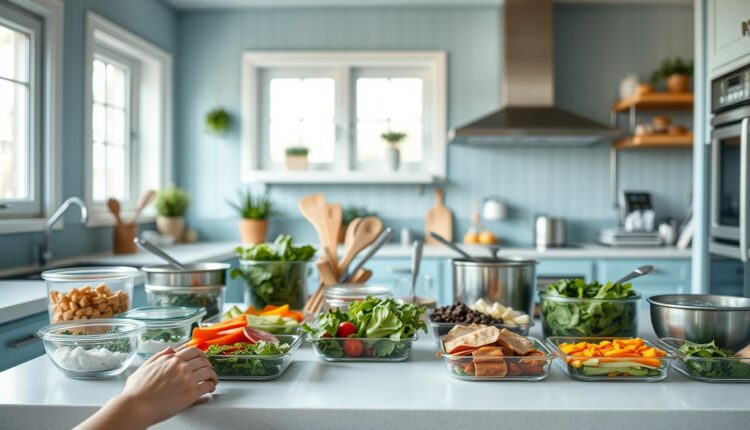Lunch Meal Prep Batch Cooking Sunday Routine
Discover the ultimate lunch meal prep batch cooking routine to simplify your Sundays and streamline your week with healthy, grab-and-go meals.
What if one afternoon could set you up for a week of delicious, stress-free lunches? I used to dread the daily scramble to throw something together until I discovered the magic of planning ahead. Now, my Sundays are dedicated to creating a kitchen rhythm that keeps our fridge stocked with fresh, ready-to-enjoy dishes.
This approach isn’t about rigid schedules or complicated recipes—it’s about building a flexible system. Think vibrant salads that stay crisp for days or hearty rice bowls you can customize in minutes. The secret? Spending a few focused hours upfront to save countless moments later.
When I first started this routine, I worried about flavors turning bland or textures getting soggy. But through trial and error (and a few container experiments!), I found strategies that keep dishes tasting like they were made that day. Best of all? You’ll spend less time washing dishes and more time savoring what matters.
Key takeaways:
- Transform Sunday into your secret weapon for hassle-free weekday lunches
- Build a flexible system that adapts to changing schedules and tastes
- Enjoy fresh, flavorful dishes without daily kitchen marathons
Embracing the Sunday Meal Prep Lifestyle
Picture this: a Sunday routine that leaves your kitchen stocked with tasty, hassle-free options. This isn’t about rigid schedules—it’s about creating space for what matters during busy days. By dedicating a few hours to smart kitchen strategies, you’ll unlock a week of flavorful possibilities without the daily scramble.
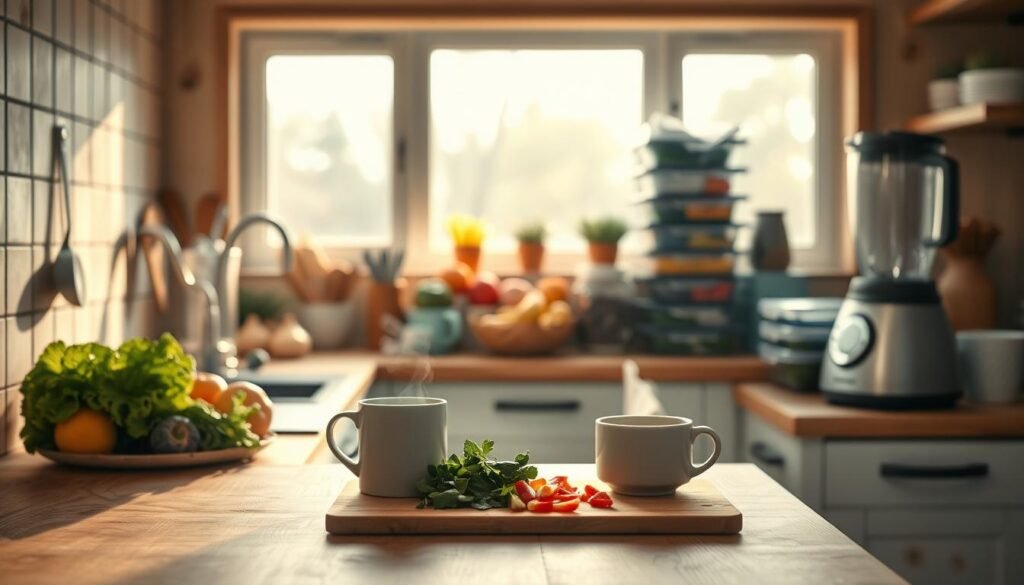
Overview of Batch Cooking Benefits
Big-batch recipes became my kitchen game-changer. Cooking larger quantities of versatile bases—like quinoa or roasted veggies—lets you mix-and-match components all week. One reader shared how this approach cut their grocery bill by 30% while reducing food waste. You’ll love discovering new flavor combinations when ingredients do double duty in salads, wraps, or grain bowls.
Why Sunday is the Perfect Day
Sunday’s rhythm naturally supports this system. It’s that sweet spot between weekend relaxation and weekday demands. I use this day to roast two sheet pans of seasonal produce while simmering a pot of lentils. By dinner time, my containers are filled with building blocks for fast, nourishing dishes. This practice turns chaotic mornings into grab-and-go moments, giving you back precious time for coffee sips or extra sleep.
Through trial and error, I’ve learned that simple recipes with bold flavors hold up best. A tangy lemon-tahini dressing can revive Thursday’s grain bowl, while fresh herbs add brightness to prepped proteins. The magic lies in balancing structure with flexibility—your future self will thank you.
Benefits of Batch Cooking for a Healthy Week
Imagine opening your fridge to find ready-to-assemble components that transform into satisfying dishes. This kitchen reality becomes possible when you harness the triple advantages of strategic planning—reclaimed time, stretched dollars, and consistent nourishment.

Time-Saving and Efficiency
Ninety focused minutes on Sunday can eliminate 45 daily minutes of kitchen chaos. While sheet pans roast veggies, marinate chicken in a zesty spice rub. Simultaneously, cook grains that’ll become stir-fry bases or salad toppers. One reader reported gaining back 3 weekly hours previously spent chopping and pan-searing.
Organize tasks like a pro: start with oven-bound items, then stovetop elements. Use waiting time to portion proteins into grab-and-go packets. By Thursday, that seasoned chicken tastes even better when briefly reheated with a splash of broth.
Cost-Effectiveness and Reduced Waste
Buying family-sized packs of chicken breasts becomes economical when used across three dishes. Leftover roasted sweet potatoes? They morph into breakfast hash or soup thickeners. A recent survey showed households using this approach reduced produce spoilage by 62%.
Here’s my favorite budget hack: cook dried beans with weekend meals. They cost a third of canned versions and freeze beautifully. Store them in 1-cup portions for instant protein boosts in future recipes.
This system works because flavors deepen over days. That garlic-herb marinade penetrates further into chicken by Wednesday. Those roasted veggies develop caramelized notes that elevate Thursday’s grain bowl. Smart storage keeps everything fresh, turning time into your flavor ally.
Prep Tools and Containers That Make Meals Last Longer
Have you ever opened your fridge to find containers leaking or ingredients gone stale? The right gear makes all the difference in maintaining freshness and streamlining your process. Let’s explore the kitchen allies that turn chaotic prep into smooth, repeatable success.
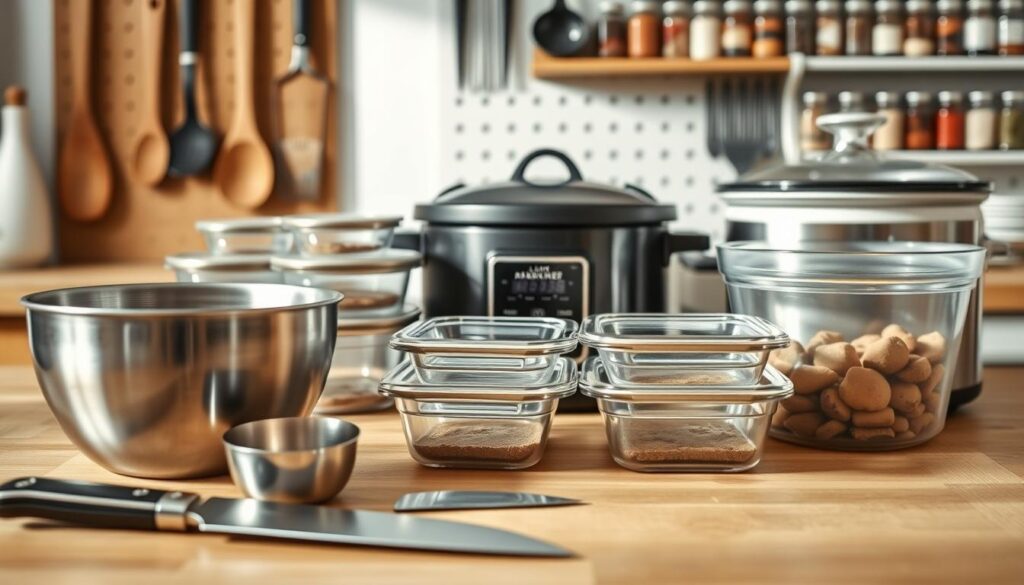
Must-Have Kitchen Equipment
Start with these workhorses:
- 8-inch chef’s knife: Cuts through winter squash and herbs with equal precision
- Half-sheet pans: Roast two trays of veggies while baking proteins
- 4-quart Dutch oven: Simmer soups or braise meats without constant stirring
I learned the hard way that dull knives waste time. A quality sharpener became my weeknight hero. For families, consider a second slow cooker—it’s perfect for cooking grains while simmering chili.
Meal Prep Containers and Storage Solutions
Glass containers with locking lids transformed my fridge. They’re microwave-safe and prevent tomato-based dinners from staining plastic. For soups, wide-mouth jars allow easy freezing and thawing.
- 1-cup freezer bags: Portion cooked beans or sauces flat for space-saving storage
- Reusable silicone lids: Fit bowls directly for no-mess marinating
A reader once shared how switching to compartment containers helped her kids build balanced plates independently. Durable gear pays for itself by surviving weekly reheating cycles—unlike flimsy alternatives that warp after three uses.
Planning Your Weekly Lunch Meal Prep
Monday morning’s hustle doesn’t have to mean frantic sandwich-making. A thoughtful blueprint turns chaotic kitchen moments into smooth assembly lines. Let’s build your game plan for success.
Creating a Balanced Menu
Start with three building blocks: proteins, vegetables, and whole grains. For breakfast, overnight oats with chia seeds offer morning convenience. Lunch could feature grilled chicken with roasted sweet potatoes and massaged kale—ingredients that stay vibrant for days.
Consider dietary needs upfront. A vegetarian option might swap chicken for marinated tofu. Gluten-free? Use quinoa instead of farro. This foresight prevents mid-week recipe scrambles.
Setting Up Your Cooking Timeline
Sunday’s workflow becomes efficient with strategic sequencing:
| Time | Task | Multi-Use |
|---|---|---|
| 9 AM | Roast vegetables | Salads, wraps, snacks |
| 10 AM | Cook grains | Bowls, stir-fries |
| 11 AM | Prep proteins | Main dishes, snacks |
One reader shared how this system helped her avoid 4pm “What’s for dinner?” panic. Her secret? A detailed shopping list organized by store sections cuts market time by half.
Remember: Your plan should bend without breaking. Leftover roasted veggies become frittata fillings, while extra grains thicken Thursday’s soup. This flexibility keeps flavors exciting while reducing waste.
Expert Tips for lunch meal prep batch cooking
Mastering your kitchen workflow starts with smart ingredient management. Through years of testing methods with home cooks, I’ve identified techniques that preserve textures and amplify flavors across multiple days.
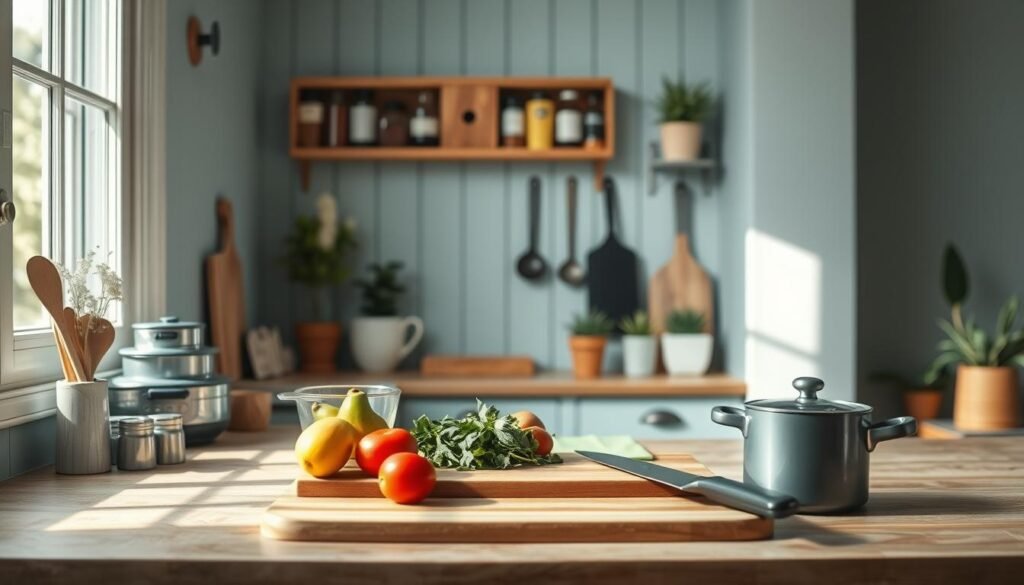
Balancing Foundations for Nourishing Combinations
Your slow cooker becomes a flavor powerhouse when cooking tougher cuts. For big batch proteins like shredded chicken, extend cooking times by 30 minutes beyond standard recipes—this ensures tenderness without drying out. Pair these with quick-cooking grains and sturdy vegetables that maintain their crunch.
| Component | Optimal Method | Storage Tip |
|---|---|---|
| Grains | Stovetop (1:2 ratio) | Freeze in muffin tins |
| Proteins | Slow cooker low heat | Store in cooking juices |
| Veggies | Roast at 425°F | Keep dressings separate |
Create visual appeal by mixing colors and textures—think ruby beets with emerald broccoli. For those seeking bold flavors, our guide to spicy marinades offers inspiration that wakes up taste buds.
Workspace organization cuts active time significantly. Group similar tasks: chop all vegetables first, then measure seasonings. This rhythm prevents cross-contamination while keeping tools within reach.
Remember: Small adjustments create big impacts. Blanching green beans before roasting preserves their snap. Toasting spices in oil unlocks deeper aromas. These subtle shifts transform routine dishes into memorable meals.
Strategies for Efficient Bulk Cooking
Ever feel like your kitchen time disappears into a black hole? Let’s turn that around with smart workflows that maximize flavor while minimizing effort. The key lies in pairing clever shortcuts with creative twists to keep your rotation exciting.
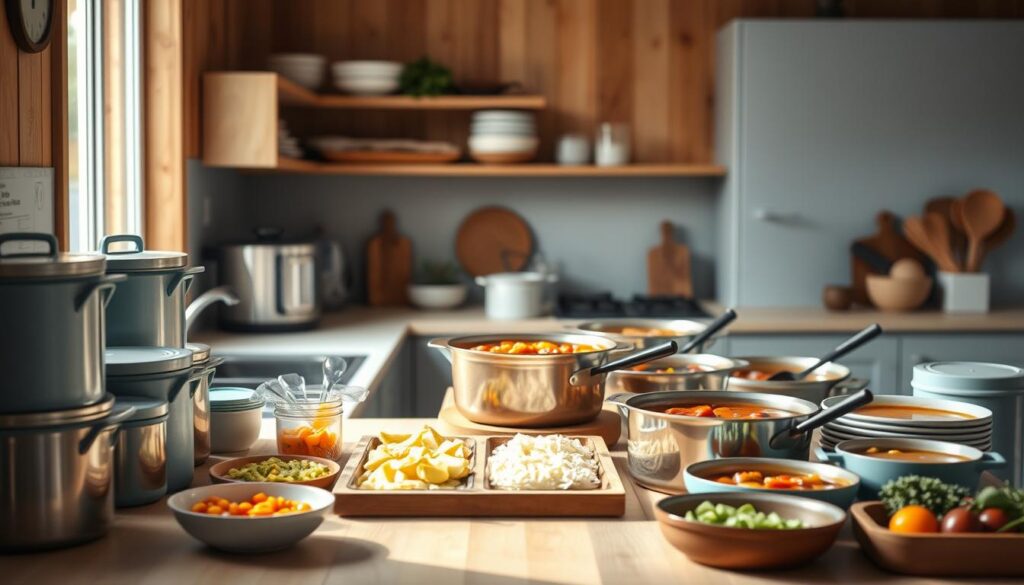
Kitchen Workflow Accelerators
Start by prepping versatile ingredients first. Chop a rainbow of vegetables while your oven preheats—they’ll roast while you tackle proteins. One reader swears by her “sizzle-and-steam” method: sauté aromatics on the stovetop while steaming greens in a stacked pot insert.
| Task | Time Saver | Multi-Use Result |
|---|---|---|
| Veggie Prep | Mandoline slicing | Salads, stir-fries, snacks |
| Protein Cook | Sheet pan roasting | Bowls, wraps, pasta toppers |
| Grain Base | Instant Pot batches | Fried rice, soup add-ins |
Flavor Reinvention Tactics
Transform base ingredients with global spices. That shredded chicken becomes:
- Thai-style with peanut sauce
- Mediterranean with za’atar
- BBQ-smoked with paprika blend
Freeze soups in silicone molds for single servings. A recent study showed freezing preserves nutrients better than refrigeration. For salads, store dressings separately in small jars—shake before drizzling to revive textures.
Rotate cooking methods throughout the week. Monday’s roasted sweet potatoes become Wednesday’s mashed soup thickener. Thursday’s sautéed greens star in Friday’s frittata. This approach keeps flavors dynamic while using every scrap.
Incorporating Fresh Veggies and Lean Proteins
Your plate becomes a canvas when you pair crisp seasonal vegetables with quality proteins. This dynamic duo forms the foundation of nourishing dishes that stay vibrant throughout the week. Let’s explore how to choose ingredients that retain their texture and nutritional value.

Selecting Seasonal Produce
Seasonal vegetables offer peak flavor and affordability. For summer, opt for zucchini ribbons and cherry tomatoes—they hold up well when stored in glass containers with parchment layers. Winter squash and Brussels sprouts roast beautifully for later use in grain bowls or morning scrambles.
Store leafy greens using the “damp towel wrap” method: line containers with clean kitchen cloths to maintain crispness. For proteins, grilled chicken thighs stay juicier than breasts during refrigeration. Plant-based options like marinated tempeh develop richer flavors by Thursday.
Pair these components with zesty dressings that do double duty. A lemon-tahini blend can coat roasted carrots on Monday, then transform into a dip for Thursday’s snack plate. Farmers market herbs like dill or basil add freshness to prepped ingredients without wilting.
Morning meals benefit from this strategy too. Spinach folded into egg muffins or roasted sweet potatoes blended into smoothies make breakfasts effortlessly nutritious. One reader shared how pre-chopped bell peppers helped her create quick frittatas while managing early meetings.
Rotate your selections monthly to keep things exciting. Asparagus in spring, peaches in summer—each season brings new opportunities to mix textures and flavors. Your taste buds (and weekly menu) will thank you.
Cooking Methods: Slow Cooker, Oven, and Stove
Your kitchen tools aren’t just appliances—they’re flavor architects. Each technique shapes ingredients differently, transforming humble components into satisfying dishes. Let’s explore how to match your recipe goals with the right heat source.
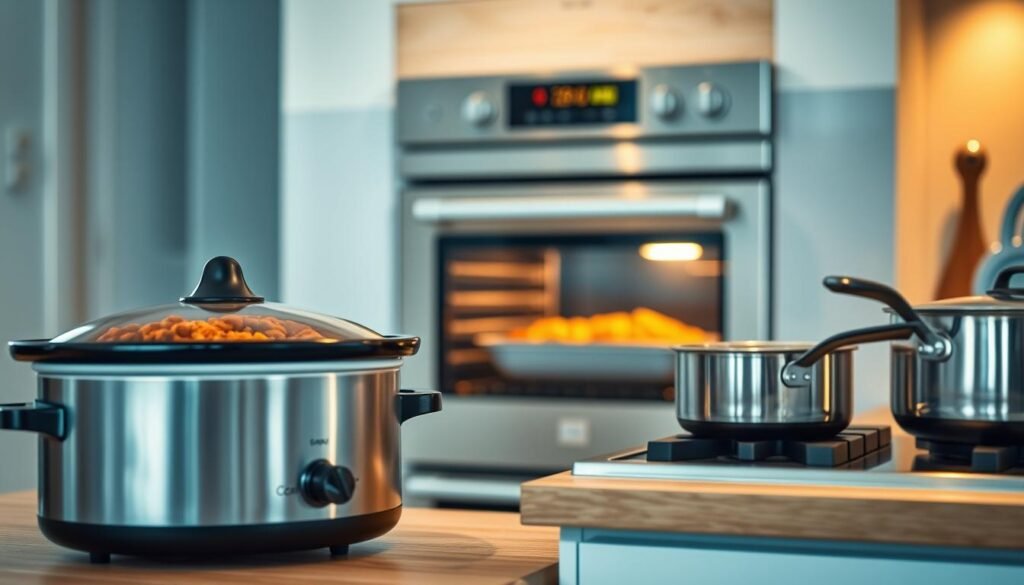
| Method | Best For | Flavor Impact | Efficiency |
|---|---|---|---|
| Slow Cooker | Soups, stews, beans | Deep, blended tastes | Low energy use |
| Oven | Roasted veggies, grain bowls | Caramelized edges | Hands-off cooking |
| Stove | Quick sautés, stir-fries | Bright, fresh notes | Fast results |
Choosing the Best Method for Your Recipe
Oven roasting unlocks crispy textures for grain bowls, while stovetop cooking preserves vibrant colors in green beans. Need tender shredded chicken? The slow cooker’s moist heat beats dry oven methods. For energy-conscious cooks, simmering beans overnight uses less power than boiling them for hours.
Advantages of the Slow Cooker for Big Batches
This appliance shines with large quantities. Tough cuts become fork-tender, and spices meld seamlessly into broths. A USDA study found slow-cooked dishes retain more nutrients than rapid-boiled versions. Pro tip: Layer hearty root vegetables at the bottom—they’ll absorb flavors while preventing overcooking.
Cleaning ease matters too. Dutch ovens need scrubbing, but removable cooker inserts go straight to the dishwasher. Match your method to the meal: gentle heat for delicate grains, high temps for crispy toppings. Your tools should work smarter, not harder.
Creating Versatile Batch Cooking Meal Components
Your kitchen becomes a flavor playground when you master reusable bases. I learned this through trial and error—like the time I overcooked three pounds of chickpeas before discovering their perfect simmer time. Now, these protein-packed gems star in salads, stews, and even crispy snacks.
Grain and Legume Mastery
Cook grains in broth instead of water for instant depth. For chickpeas, soak overnight with baking soda to ensure creamy centers. Portion cooked legumes into 1½-cup servings—the ideal amount for component cooking across multiple dishes.
Sauce Alchemy
A well-crafted sauce reinvents leftovers. My go-to formula: 2 parts creamy base (tahini/yogurt) + 1 part acid (lemon/vinegar) + aromatics (garlic/herbs). Triple the batch—it’ll dress roasted veggies, marinate proteins, or become a dip.
Store components smartly:
- Grains: Freeze in muffin tins for single servings
- Sauces: Use squeeze bottles for mess-free drizzling
- Chickpeas: Keep in cooking liquid to prevent drying
Flavor layering makes all the difference. Toss warm quinoa with vinaigrette before cooling—it absorbs seasoning better. For families, set up a “build your bowl” station with prepped elements. This approach transformed my niece’s picky eating habits!
Need morning inspiration? Those same chickpeas blend beautifully into family breakfasts like savory pancakes. The key is viewing each component as a blank canvas—a little creativity yields endless combinations.
Meal Prep Recipes to Try: Salads, Bowls, & Soups
Three recipe categories can revolutionize your weekday routine. Let’s explore dishes that stay vibrant for days and adapt to changing cravings. The key lies in smart ingredient pairings and storage tricks that preserve textures.
Hearty Salads and Rice Bowls
My Mediterranean quinoa salad stays crisp thanks to a simple trick: store dressings separately. Combine cooked grains with cucumbers, olives, and feta—add chickpeas for protein. For rice bowls, layer components vertically to prevent sogginess.
| Component | Prep Tip | Shelf Life |
|---|---|---|
| Leafy greens | Line containers with paper towels | 4 days |
| Cooked rice | Cool completely before sealing | 5 days |
| Roasted veggies | Store uncovered for 30 minutes first | 6 days |
One reader transformed her work lunches by swapping mayo-based dressings for lemon-tahini blends. Her Tuesday salad tasted as fresh as Monday’s thanks to this adjustment.
Easy-to-Reheat Soups and Stews
Chicken tortilla soup freezes beautifully when you omit dairy. Portion into jars, leaving headspace for expansion. Reheat gently with a splash of broth to revive textures. Lentil stew gains depth by Thursday—its spices meld beautifully over time.
Freeze soups flat in bags for space-saving storage. A client reported her freezer stash helped during unexpected busy weeks. “Having three options prevented takeout temptation,” she shared.
Simple upgrades make basics shine. Top minestrone with crispy chickpeas instead of croutons. Stir fresh herbs into butternut squash soup before serving. These touches keep flavors exciting while maintaining make-ahead convenience.
Managing Portions and Storage for Freshness
The secret to stress-free weekday eating lies in your fridge organization strategy. Glass containers with tight seals became my game-changer—they keep bell peppers crisp for six days and bean salads vibrant. I learned this after a disastrous week of wilted greens and soggy muffins that taught me the value of intentional storage.
Labeling and Organizing Your Meals
Masking tape and a sharpie transformed my kitchen sanity. Date every container—you’ll avoid guessing games with Thursday’s chili. For portion control, I use 1-cup silicone molds to freeze bean-based soups into single servings. This prevents overeating while ensuring balanced nutrition.
Storing sensitive ingredients requires specific solutions:
- Bell peppers stay crunchy in vented containers lined with paper towels
- Muffins retain moisture in beeswax wraps followed by airtight tins
- Cooked beans last longer when stored in their cooking liquid
Arrange your fridge like a grocery store—proteins on lower shelves, ready-to-eat items at eye level. A reader shared how this system helped her family reduce food waste by 40%. For freezer organization, stack flat soup bags vertically like books on a shelf.
| Food | Ideal Container | Max Freshness |
|---|---|---|
| Chopped peppers | Glass jar with lid | 5 days |
| Bean salads | Compartment tray | 4 days |
| Baked muffins | Metal tin with liner | 7 days |
Balance is key—portion proteins using your palm size as a guide, grains to a fist-sized scoop. This method adapts to different hunger levels while preventing calorie overload. Your future self will thank you when Wednesday’s lunch tastes as fresh as Sunday’s masterpiece.
Overcoming Common Meal Prep Challenges
We’ve all faced that moment – opening a container to find limp greens or bland grains that lost their spark. Through countless kitchen experiments at home, I’ve discovered simple fixes that keep dishes vibrant. Let’s tackle these hurdles together, turning frustration into delicious solutions.
Maintaining Texture and Flavor
Crunch matters. Store dressings separately in small jars – shake before drizzling to revive Thursday’s salad. For grain bowls, layer ingredients vertically: grains at the bottom, proteins in the middle, crispy veggies on top. This prevents sogginess better than horizontal stacking.
Feta became my flavor hero after a Greek salad disaster. Its briny punch survives refrigeration better than delicate herbs. Crumble it over roasted vegetables or fold into wraps – it adds zing without extra prep. Acidic elements like pickled onions or lemon zest also combat flavor fade.
“Storing components separately transformed my home kitchen routine – now my Friday lunches taste as fresh as Monday’s.”
When freezing soups, leave space for expansion and label with dates. Reheat gently with a splash of broth or citrus juice. For roasted veggies, pat them dry before storing – moisture is the enemy of crispness.
Embrace the trial process. My first attempt at prepped sandwiches turned bread soggy, but switching to hearty whole-grain wraps solved it. Every home cook’s journey includes these lessons – they’re stepping stones, not setbacks.
Tips for a Family-Friendly Batch Cooking Routine
Transforming kitchen time into family moments starts with smart planning. When my niece refused anything green, I discovered colorful wraps could hide spinach while letting her choose fillings. Now, our Sunday sessions include “build your own” stations where everyone crafts their perfect plate.
Kid-Approved Flavor Adventures
Sweet potato black bean wraps became our weekday hero. Spread peanut sauce on whole-grain tortillas, then let little hands layer roasted veggies and protein. For picky eaters, serve components separately—crunchy cucumbers here, shredded chicken there. Egg muffins with hidden zucchini work for breakfasts and snacks.
Involve kids in safe tasks:
- Washing cherry tomatoes
- Pressing cookie cutters on watermelon slices
- Sprinking cheese on taco bowls
“Letting my daughter assemble her lunch box changed everything—she eats what she creates!”
Flexible Formulas for Diverse Needs
Our peanut sauce doubles as dip and dressing. For allergies, swap sunflower butter and omit honey. Gluten-free? Use lettuce wraps instead of tortillas. Batch-cook taco meat separately from beans to accommodate vegetarians.
Store components in clear containers labeled with emojis—kids love claiming their favorites. Rotate two base recipes weekly to prevent boredom: one Asian-inspired, one Mexican-themed. This system adapts to growth spurts and changing tastes while keeping everyone nourished.
Start Strong with Smart Sunday Prep Rituals
Your kitchen journey begins with a single Sunday session. Whether you’re roasting colorful vegetables or mixing a zesty sesame ginger dressing, each step builds confidence. Remember the reader who transformed her mornings by simply storing dressings separately? That could be you next week.
Recap of Key Meal Prep Strategies
Start with these fundamentals:
- Rotate cooking methods to keep flavors exciting
- Store components in clear containers for easy identification
- Pair sturdy fresh veggies with quick-cooking proteins
One game-changing tip: freeze sauces in ice cube trays. Those frozen flavor bombs transformed my Thursday stir-fries. As one home cook shared, “Having prepped components feels like having a personal chef.”
Preparing for Your Next Cooking Session
Grab your calendar and mark your next prep day. Try this easy make-ahead formula:
- Choose one protein (chicken thighs work beautifully)
- Pick two seasonal vegetables (bell peppers and zucchini are versatile)
- Make one sauce (sesame ginger works for bowls and salads)
Need inspiration? Our clean eating meal prep guide offers fresh combinations. Every session teaches something new—maybe you’ll discover roasted carrots taste better chilled, or that kale softens perfectly when massaged early.
Your next step? Set out containers tonight. When you wake up to an organized kitchen, you’ll feel ready to create. What new recipe will you try first?
Let this be your turning point. Those stocked containers of seasoned chicken and fluffy brown rice? They’re more than food—they’re freedom from daily chaos. I’ve seen families transform their evenings simply by keeping cooked proteins and roasted veggies ready to assemble.
Start with one pan of garlicky chicken thighs and a pot of brown rice. Use them in wraps, grain bowls, or stir-fries all week. My neighbor Sarah saved $78 weekly this way while finally hitting her nutrition goals. The magic lies in repetition without boredom—swap sauces or spices to keep taste buds guessing.
Remember: Meal prepping grows with you. Begin with basics like roasted sweet potatoes and hard-boiled eggs. As confidence builds, try marinated tofu or freezer-friendly soups. Every Sunday effort compounds—like money in a savings account for your future self.
Share your wins (and funny fails!) using #RealMealPrep. Did your curry sauce thicken into cement? We’ve all been there. Your story might inspire someone else to start their journey.
Grab those containers. Preheat the oven. Let’s make next week deliciously effortless—one protein-packed lunch dinner at a time.
Roasted Veggie & Farro Salad with Lemon-Herb Vinaigrette
A hearty and nutritious salad featuring roasted vegetables and chewy farro, tossed in a zesty lemon-herb vinaigrette. Perfect as a main dish or side, this salad is both satisfying and flavorful.
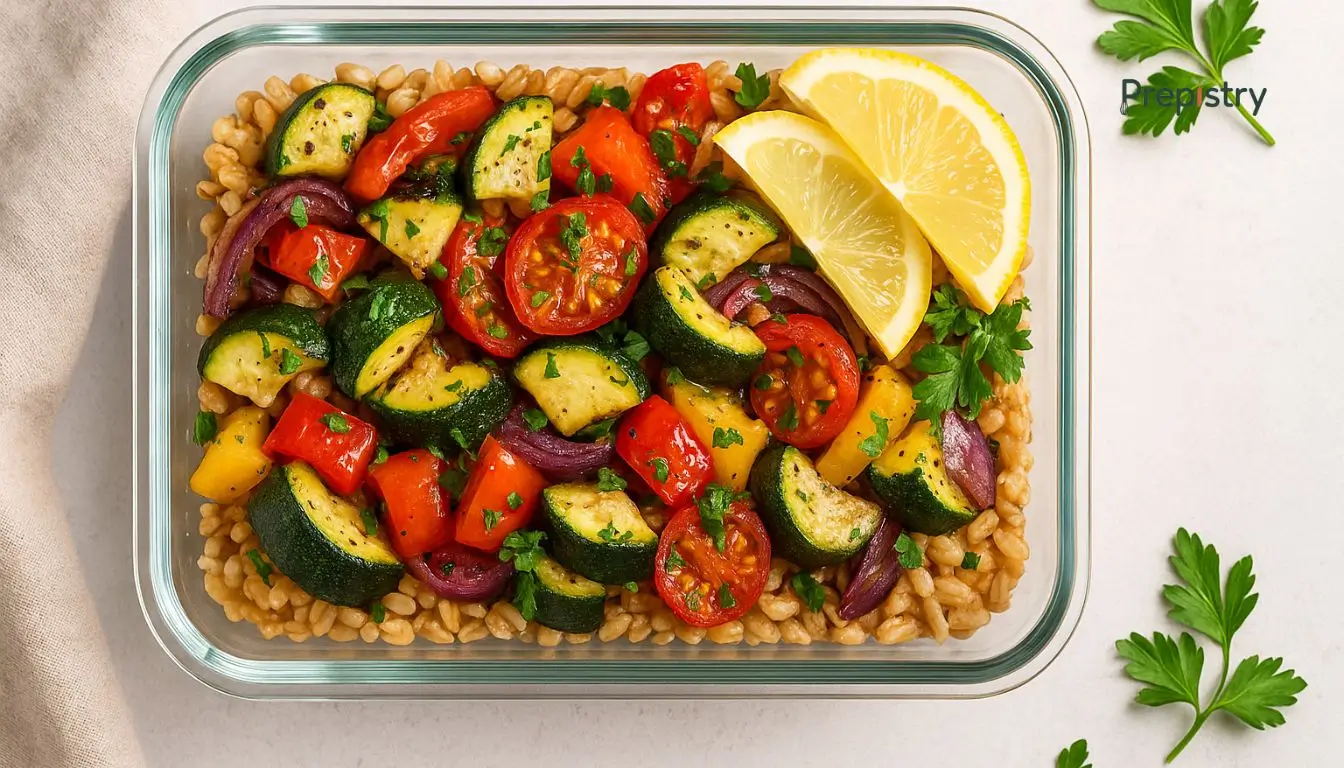
Nutrition Information
Equipment Needed
- Baking sheet
- Medium saucepan
- Large mixing bowl
- Whisk
- Cutting board
- Chef's knife
Ingredients
-
1 cup farro
-
2 cups water or vegetable broth
-
1 medium zucchini, chopped
-
1 red bell pepper, chopped
-
1 yellow bell pepper, chopped
-
1 red onion, sliced
-
1 cup cherry tomatoes, halved
-
2 tablespoons olive oil
-
Salt and pepper to taste
-
1/4 cup chopped fresh parsley
-
1/4 cup crumbled feta cheese (optional)
-
For the vinaigrette:
-
1/4 cup olive oil
-
2 tablespoons fresh lemon juice
-
1 teaspoon Dijon mustard
-
1 teaspoon honey
-
1 clove garlic, minced
-
1 teaspoon dried oregano
-
Salt and pepper to taste
Instructions
Recipe Video
Roasted Veggie & Farro Salad with Lemon-Herb Vinaigrette
Learn how to make a delicious and healthy roasted vegetable and farro salad with a refreshing lemon-herb vinaigrette.

